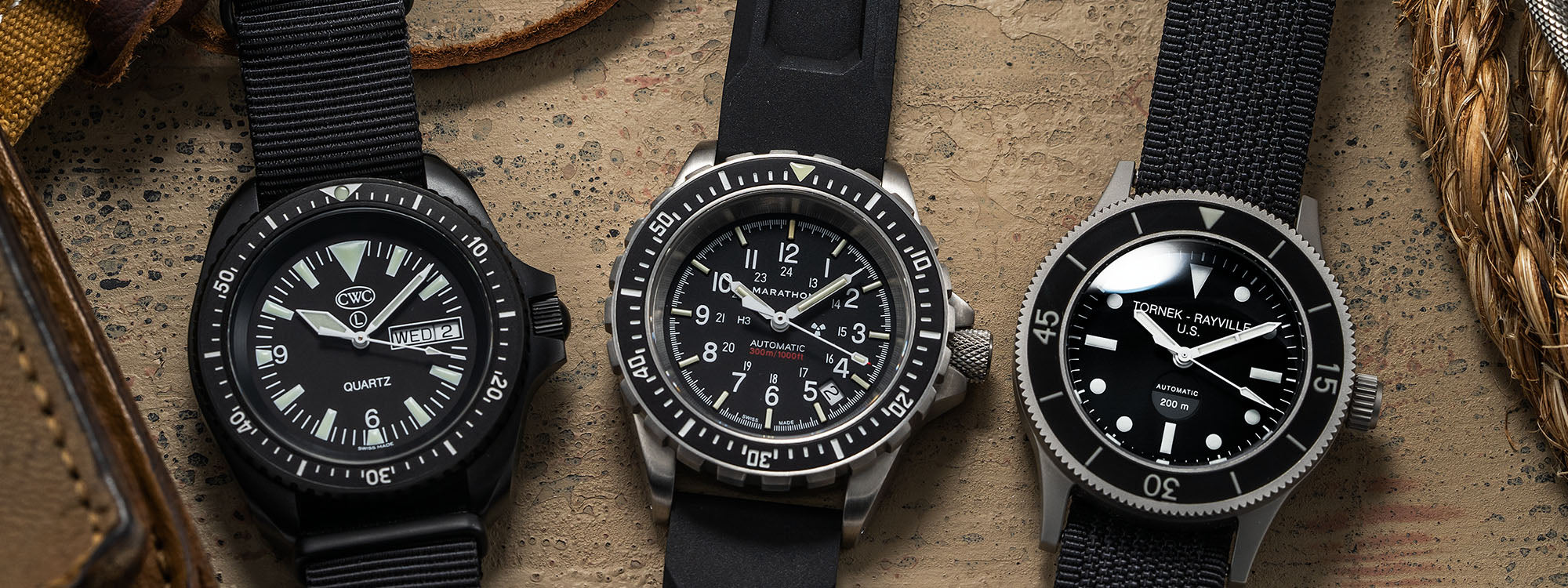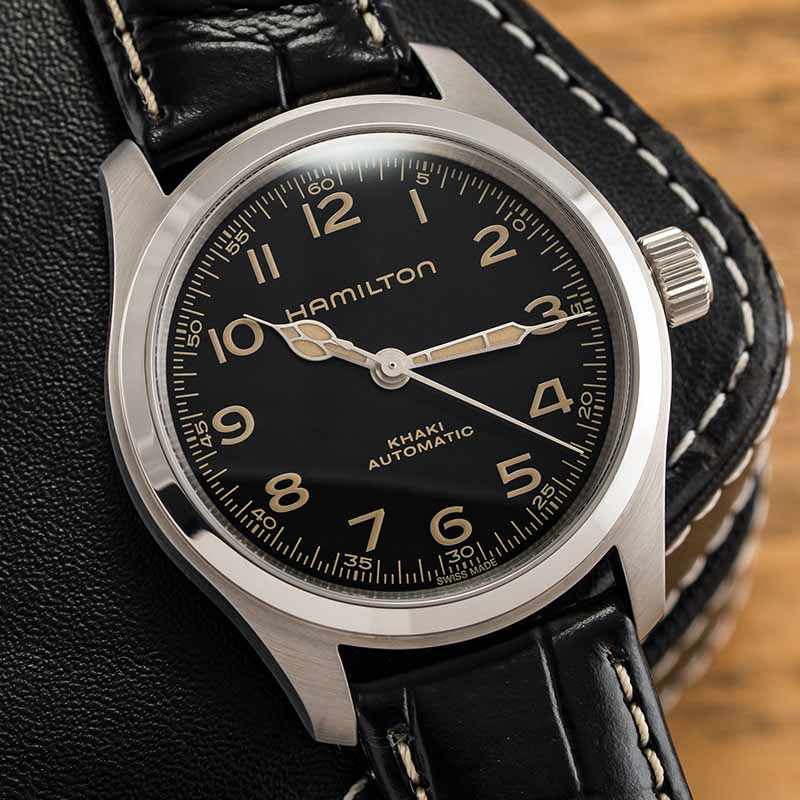Among the many decisions facing a prospective watch buyer before pulling the trigger on a new timepiece is choosing which type of strap or bracelet it should have. Watch straps vary widely in their materials, construction, finishing, and even in their original intended usage, with some straps projecting a sense of genteel refinement and others possessing military ruggedness or everyday sportiness. Here is a look at five watch strap types, their origins, and their attributes.
Dress Leather Strap

The practice of attaching watches to leather straps goes all the way back to the Boer Wars of the late 19th Century, which were fought in South Africa. British soldiers began wearing their pocket watches on crude leather attachments rather than in their jacket pockets because they often needed to doff their jackets and waistcoats in the extreme African heat. By the early 1900s, pioneers like London saddlemaker Alfred Pearson and Swiss watch importers the Dimier brothers were converting pocket watches into wristwatches by soldering wire lugs onto the cases and slipping such leather wristlets through them to secure them to wrists. The style became widespread after World War I, during which military men wore these wristwatches on the battlefield, and entered the realm of high fashion in subsequent years. Leather straps are usually made from calfskin, alligator, or crocodile leather (the latter two generally being associated with a higher level of luxury), but other, more exotic types of leather have been used, including snakeskin, ostrich, and stingray. Most leather straps have small buckle adjustment holes and loops called “keepers” that are used to adjust the fit to the wearer’s wrist size and to keep the strap in place without dangling. They are generally constructed of two or more layers, held together by stitching, which is either “tone-on-tone” (the thread used for stitching matches the color of the leather for a monochromatic look) or “contrast” (the stitching is in a different highlight color that stands out). Leather straps are soft to the touch and generally signify a watch worn in formal circumstances. They are not great at resisting water and will eventually wear out and need to be replaced — which is less of an issue with rubber straps and metal bracelets — but cleaning them regularly will keep them supple longer and help them to avoid cracking.
Rubber Strap

Vulcanized rubber, an innovation by chemist and tire-company namesake Charles Goodyear, originated in 1839 and the first watch straps made from the material emerged in the 1950s. This type of rubber has several practical advantages over leather, being stronger, more resilient, more pliable (i.e., it returns to its original shape after bending), and more resistant to water and higher temperatures. Rubber straps for watches became more mainstream in the 1960s with the rising popularity of recreational diving and the demand for water-resistant divers’ watches that came with it. While rubber straps retain a strong association with sports watches and tool watches, some high-end luxury watches are also offered with a rubber strap option; Hublot was one of the first watchmakers to merge the two worlds, famously releasing the first gold watch on a rubber strap back in 1980. In addition to the attributes mentioned above, rubber straps can host a wide variety of colors and textures (as on the Longines Hydroconquest model pictured). The only downside to this type of strap is that in very hot, humid conditions, the inside of it can become uncomfortably sticky on the wrist.
NATO/Zulu Strap

First utilized in watches issued to battlefield troops in the early 20th Century, a NATO strap is a one-piece “pass-through” strap, usually made of nylon or some other fabric, that loops under the watch’s case and through its spring bars to hold it securely in place on the wrist. Like all inventions that originated for a military purpose, its design emphasized utility, practicality, and secure use on the field of battle: such a strap construction would hold the watch in place, albeit dangling precariously, even if one of the spring bars were broken. An authentic, military-issue NATO strap is referred to as a “G10,” a reference to the army requisition form that one would file to order one, and comes in the original “Admiralty Grey” color. Watch brands nowadays offer many different variations in both colorways and materials. (We delve deeper into the NATO strap, its history, and its variations, in this article.) The other type of “pass-through” strap is called a Zulu strap, which is very similar to the NATO but has a thicker nylon weave, thicker and more rounded buckles and keepers compared to the rectangular ones common to the NATO, and a higher level of robustness in general.
Bund Strap

As their teutonic-sounding name would imply, Bund straps originated in Germany (Bundesrepublik Deutschland) during World War II, specifically as an option for pilots. The Bund's telltale feature is a protective leather backing under the main strap that serves to cushion the metal watch case and shield the wearer’s wrist from intensely hot or cold conditions that could make the watch uncomfortable to wear. The extra backing, which usually includes loops through which the main strap can be inserted, also absorbs sweat from the skin and prevents it from affecting the watch. Bund straps, which are few and far between these days, are among the sturdiest options out there, though few would consider them appropriate for a dressier ensemble. Their sheer size might also make them a bit too ostentatious (or a bit too “biker”) for some.
Aviator Strap

Classical aviator straps, most often made of thick calfskin leather, represent a retro look that is still popular today. The first pilots’ watches made for the military, circa the 1930s and ‘40s, were meant to be worn over the bulky sleeves of a flight jacket, which meant the leather straps fastened to them needed to be uncommonly thick, sturdy, and longer than that of a dressier watch. Many of these rustic-looking bands used steel rivets to ensure the watch was solidly attached. In the earliest days of military aviation, some watches had an even longer, more robust strap, reminiscent of a leather belt, for bomber pilots who strapped their timekeepers to their legs to free up their arms to work the controls. Modern, vintage-look pilots' watches, from makers like IWC, Laco, and other brands with a history of supplying military air units, are often mounted on these type of straps. Unless you're going for that statement-making flyboy look, however, they can look out of place as part of a more business-casual ensemble.
Sailcloth/Canvas/Cordura Strap

Occupying something of a middle ground between the sportiness of rubber and the formality of leather are straps made of tough, hardwearing nylon fabrics like sailcloth, cordura, and kevlar. Blancpain, with its genre-defining Fifty Fathoms divers’ watch, was among the first to use such a material, and still offers sailcloth straps (yes, it’s the material used in the nautical industry to make sails for ships) on many of its sport-luxury pieces. Soft yet very durable — and unlike leather, water-resistant enough to be submerged underwater for a stretch — these types of straps, depending on the watch they’re attached to, of course, generally look right at home whether on a boat or in a boardroom. If you're looking to wear one on a dive, however, keep in mind that most rugged fabric straps sold these days have a leather inner lining for increased wrist comfort, which would limit their use for serious underwater exploits.
Milanese/Mesh Strap

The only strap on this list made of metal, an argument can certainly be made that the Milanese (sometimes also called “beads-of-rice”) style is more of a bracelet than a strap (we’ll cover bracelet types in another article). However, the way it is constructed — with a series of small metal wires woven into a mesh pattern, and deriving its name from a technique perfected in 19th-century Milan — makes this type of wristlet much more supple than a bracelet, which by definition is made of individual links, and much more adjustable in minuscule increments. Style-wise, Milanese straps can be dressed up or down, they’re built to last longer than straps made of leather or fabrics, and depending on the timepiece can look either vintage or contemporary. Like its link-bracelet cousins, however, it can occasionally pinch the tiny hairs on a wearer’s wrist.
























































0 Comments